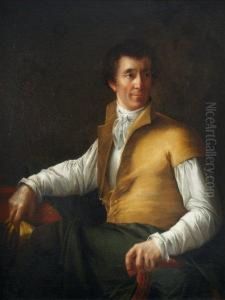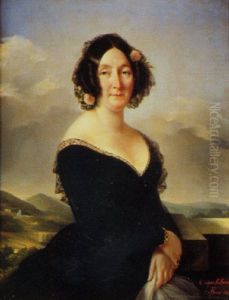Eugenie Tripier Lefranc Paintings
Eugenie Tripier Lefranc was a French artist born in 1819, during a period when the world of fine arts was predominantly male-dominated. Despite the societal challenges of her time, she managed to carve out a space for herself as a respected painter. Lefranc's work is often characterized by its delicate sensibilities and attention to detail, which was typical of the artistic trends during the 19th century.
Eugenie's artistic talents were recognized from an early age, and she was fortunate to receive training in the arts. She was particularly known for her portrait paintings, through which she was able to capture the essence and character of her subjects with a remarkable finesse. Her portraits were not just mere representations; they were imbued with the emotional depth and psychological insight that elevated them beyond the standards of her time.
Lefranc's career spanned much of the 19th century, a dynamic period in the history of art that saw the transition from neoclassicism to romanticism, and later to realism and impressionism. Though not much is widely known about her personal life or her artistic journey, Eugenie Tripier Lefranc’s works do reflect the shifting tastes and styles of the period. Her ability to adapt to these changing aesthetics is indicative of her skill and versatility as an artist.
In addition to portraits, Lefranc also painted genre scenes, religious themes, and still lifes. These subjects allowed her to explore different aspects of painting, from depicting the mundanity of everyday life to the spiritual and the sublime. She participated in various exhibitions, including the prestigious Salon in Paris, which was the official art exhibition of the Académie des Beaux-Arts in Paris. Being able to exhibit there was a significant achievement for any artist of that era, and it provided her with the opportunity to gain wider recognition and respect among her peers and art enthusiasts.
Despite her obvious talent and the quality of her work, Eugenie Tripier Lefranc, like many women artists of her time, did not receive the same level of attention and acclaim as her male counterparts. It wasn't until the late 20th and early 21st centuries that art historians began reassessing the contributions of female artists and giving them their rightful place in the annals of art history.
Eugenie Tripier Lefranc passed away in 1898, leaving behind a legacy that reflects the quiet perseverance of women artists in the 19th century. Her paintings continue to be studied and appreciated for their technical proficiency and their unique perspective, offering insight into the life and times of a female artist in an era that was just beginning to acknowledge their presence and impact in the world of art.

